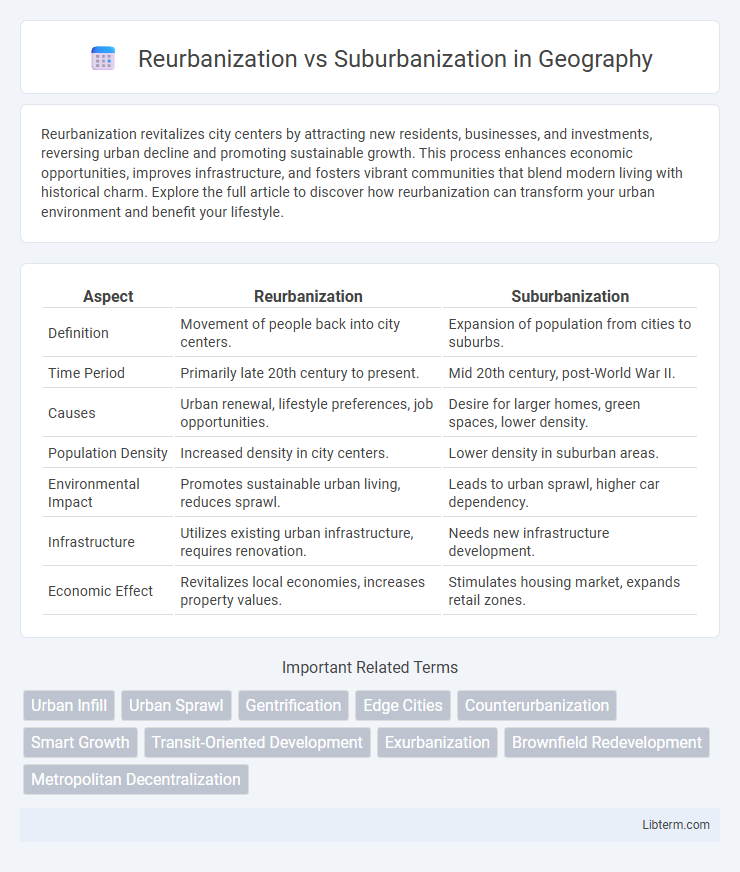Reurbanization revitalizes city centers by attracting new residents, businesses, and investments, reversing urban decline and promoting sustainable growth. This process enhances economic opportunities, improves infrastructure, and fosters vibrant communities that blend modern living with historical charm. Explore the full article to discover how reurbanization can transform your urban environment and benefit your lifestyle.
Table of Comparison
| Aspect | Reurbanization | Suburbanization |
|---|---|---|
| Definition | Movement of people back into city centers. | Expansion of population from cities to suburbs. |
| Time Period | Primarily late 20th century to present. | Mid 20th century, post-World War II. |
| Causes | Urban renewal, lifestyle preferences, job opportunities. | Desire for larger homes, green spaces, lower density. |
| Population Density | Increased density in city centers. | Lower density in suburban areas. |
| Environmental Impact | Promotes sustainable urban living, reduces sprawl. | Leads to urban sprawl, higher car dependency. |
| Infrastructure | Utilizes existing urban infrastructure, requires renovation. | Needs new infrastructure development. |
| Economic Effect | Revitalizes local economies, increases property values. | Stimulates housing market, expands retail zones. |
Introduction to Reurbanization and Suburbanization
Reurbanization refers to the process where population and economic activity return to urban centers that experienced decline, driven by factors such as urban renewal, improved infrastructure, and changing lifestyle preferences. Suburbanization involves the outward expansion of cities as people move to residential areas on the urban fringe, motivated by affordable housing, better schools, and lower crime rates. These contrasting demographic trends shape metropolitan growth patterns and influence urban planning policies.
Historical Context and Evolution
Reurbanization refers to the process of population and economic growth returning to urban centers following periods of decline, which gained momentum in the late 20th century as cities underwent revitalization efforts after mid-century suburban flight. Suburbanization, dominant in the post-World War II era, involved large-scale migration from urban cores to peripheral suburbs driven by affordable housing, increased automobile use, and changing social aspirations. The historical evolution of these trends reflects shifts in economic structures, transportation technologies, and policy priorities that have alternately expanded metropolitan peripheries or reinvested in central city districts.
Key Drivers of Reurbanization
Reurbanization is driven primarily by increased demand for urban living due to economic opportunities, cultural amenities, and improved transportation infrastructure that enhances city accessibility. Factors such as urban renewal projects, rising environmental awareness promoting walkability, and shifts in demographic preferences towards vibrant, mixed-use neighborhoods also contribute significantly. These drivers contrast with suburbanization, which is often fueled by affordable housing, larger living spaces, and perceived safety outside city centers.
Factors Fueling Suburbanization
Economic opportunities and affordable housing in suburban areas significantly fuel suburbanization by attracting families and young professionals seeking better living conditions. Improved transportation infrastructure, including highways and public transit expansions, facilitates easier commutes from suburbs to urban job centers. Lifestyle preferences for larger homes, increased privacy, and access to recreational spaces further drive population shifts from urban cores to suburban neighborhoods.
Demographic Shifts and Population Trends
Reurbanization reflects a demographic shift where younger professionals and empty nesters move back to urban centers, reversing decades of suburban growth and contributing to increased population density in city cores. Suburbanization involves population dispersion as families seek larger homes, affordable living, and perceived safety, driving growth in suburban and exurban areas. Population trends reveal that reurbanization often correlates with urban revitalization efforts, increased public transit access, and lifestyle preferences favoring walkability, while suburbanization aligns with automobile dependency and spatial decentralization.
Urban Planning and Infrastructure Impact
Reurbanization revitalizes city centers by concentrating investments in public transit, mixed-use developments, and sustainable infrastructure, reducing urban sprawl and traffic congestion. In contrast, suburbanization emphasizes expanding road networks, single-family homes, and car-dependent infrastructure, often leading to fragmented land use and increased demand for utilities. Urban planning strategies must balance these dynamics to enhance connectivity, optimize resource allocation, and promote equitable growth in metropolitan regions.
Economic Implications and Job Markets
Reurbanization drives economic revitalization by attracting businesses, increasing property values, and stimulating job growth in urban centers, particularly in sectors like technology, finance, and creative industries. Suburbanization often shifts economic activity toward residential development and retail, promoting job creation in construction, services, and logistics but can lead to decentralized employment hubs and longer commute times. The contrasting dynamics influence local labor markets, income distribution, and regional economic competitiveness, shaping urban and suburban economic landscapes.
Environmental Considerations and Sustainability
Reurbanization promotes sustainability by reducing urban sprawl, lowering greenhouse gas emissions, and encouraging the reuse of existing infrastructure. Suburbanization often increases reliance on automobiles, leading to higher carbon footprints and greater land consumption, which challenges environmental preservation efforts. Prioritizing green spaces and energy-efficient developments within reurbanized areas supports long-term ecological balance and resource conservation.
Social and Cultural Dynamics
Reurbanization fosters diverse social interactions and cultural revitalization by attracting younger, often more diverse populations to city centers, leading to increased community engagement and support for arts and cultural institutions. Suburbanization typically promotes homogeneous social structures and cultural conformity, emphasizing private space and automobile dependency, which can limit cultural exchange and social cohesion. The contrasting dynamics between these processes shape urban identity, with reurbanization enhancing multicultural vibrancy and suburbanization reinforcing traditional, less diverse social patterns.
Future Outlook: Balancing Urban and Suburban Growth
Reurbanization emphasizes revitalizing city centers through sustainable development, increased public transit, and mixed-use projects, aiming to accommodate growing urban populations and reduce environmental impact. Suburbanization continues to appeal for affordable housing and larger living spaces but is increasingly integrating smart growth principles and enhanced connectivity to urban cores. Balancing urban and suburban growth in the future requires coordinated policies promoting density, green infrastructure, and equitable access to services, ensuring sustainable expansion across metropolitan regions.
Reurbanization Infographic

 libterm.com
libterm.com